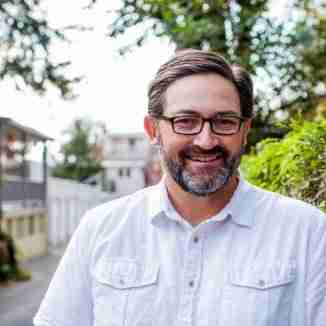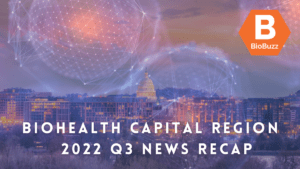
2019 BioHealth Capital Region Forum Insights and Key Takeaways
April 10, 2019
The 5th annual Biohealth Capital Region (BHCR) Forum was held on April 8th and 9th at AstraZeneca in Gaithersburg, MD. Biotech and life science executives and expert speakers from industry, academia, healthcare, government, finance and real estate development, among others, converged to discuss the BHCR’s path forward to becoming a top three U.S. biotech cluster by 2023.
Rich Bendis, CEO of BioHealth Innovation, and host of the forum welcomed the 1,200 registered attendees (double the number of the first forum) with the annual update on the region’s progress towards that goal. After moving up one spot in 2018 to number four, according to GEN Biotechnology’s annual rankings, the BHCR is building momentum fueled by record VC investment, new lab space and multiple new companies moving into the region.
Breakout sessions, new Ted Talk-style presentations and a host of panel discussions touched on a wide array of important topics from the state of the BHCR ecosystem and keys to entrepreneurial success to university-industry bio partnerships and BHCR vs Silicon Valley, to name just a few session topics.
A number of important messages emerged across this two-day meeting of the minds, which was kicked off with inspirational words from Secretary Schulz of the Maryland Department of Commerce whose message to the audience was to “Go forth and keep fixing things.” After two days of lively discussion, the event culminated in a major BHCR press announcement occurring shortly after the final panel ended.
The BioBuzz team was on hand for it all and came away with these top five takeaways from the 2019 BHCR Forum:
1.AstraZeneca Reconfirms Commitment To BHCR. Jean-Charles Soria, SVP, Early ICA/R&D Oncology Leadership Team at AstraZeneca discussed the retirement of the MedImmune brand and emphatically confirmed AZ’s commitment to the BHCR in the post-Medimmune era. During his keynote on “The Future of Healthcare & the Biotech Industry”, Soria clearly indicated that AZ will continue to invest in the BHCR and will be a strong advocate for the region’s ascension to be top 3 biocluster by 2023.
2. Investment Capital Is Still A Big Need. Time and again audience members, panelists and moderators–and many people networking in between sessions–noted that a dearth of investment capital in the BHCR is an ongoing challenge, particularly for early stage companies perceived to be higher risk ventures. The “conservative” investment mindset of the region, it was noted, contributes to the difficulty startups and growth-stage companies encounter when seeking financial support outside of more readily available government grant and tax credit opportunities.
3. Regional Talent Is A Strength. Speaker after speaker lauded the BHCR’s strong pool of talent produced by major research universities, the workforce development pipeline, industry and government research entities. The regional talent base was widely praised as one of the BHCR’s most valuable assets. While the region is talent rich, discussions at the forum also revealed an overall scarcity of commercial talent in sales, marketing and commercial operations. This could change soon, however, as Kite Pharma’s new facility in Frederick County, MD could be the new commercial talent anchor the BHCR needs to help fill this talent gap.
Leaders Discuss Top Priorities for Workforce and Infrastructure to Grow BioHealth Capital Region
4. All The Ingredients for Robust Growth Are Here. The elements needed to become a top 3 (and maybe even a higher ranking) bio hub by 2023 are all right here in the BHCR: Amazing research universities like Johns Hopkins and the University of Maryland; state and local government programs that foster innovation and growth; powerful government research entities like NIH and others; a deep and highly qualified talent pool; a burgeoning cell and gene therapy sub-cluster; and a host of promising life science startup companies with an already strong yet evolving support infrastructure. What’s needed now, according to many at the forum, is for the entire BHCR to pull in one direction to overcome challenges like the wide geographic range of the region, workforce development, talent competition and capital investment attraction.
5. Johnson & Johnson, BARDA and Children’s National Health System Launch JLabs @ Washington D.C. Throughout the day hints were dropped by Children’s National President and CEO Kurt Newman and other Children’s representatives about big things happening with the Children’s National Medical Center and the Walter Reed National Military Medical Center Campus. Newman discussed the new Children’s National Research and Innovation Campus in Washington, D.C. that will develop new treatments and technologies for pediatric applications and provide needed incubator space for the region.
Almost immediately following the BHCR forum’s last panel, the announcement came across the wire that Johnson & Johnson, BARDA and Children’s were bringing JLabs @ Washington D.C. to the Innovation Campus at Walter Reed.

The 32,000 square foot JLABS @ Washington, DC site will be “…open to pharmaceutical, medical device, consumer and health technology companies that are aiming to advance the development of new drugs, medical devices, precision diagnostics and health technologies, including applications in pediatrics”, according to the official press release.
The arrival of JLABS in the BHCR is yet another sign of the region’s continued growth and vibrancy. The announcement was indeed the perfect ending to a productive, informative and forward-thinking two-day forum. It’s also an important regional development that will certainly be a boon to BHCR start-ups and growth-stage companies who have yearned for years to have a true “accelerator” program in the region, in addition to being a big win for pediatric health innovation.
Unlike years past, this forum didn’t end with a call to arms or new important ecosystem agenda item to face. Instead, it ended with a quiet confidence that we’re on the right track and we need to keep doing what we’re doing. The region, the key players and the many people within the community are now committed to building a world-class cluster and helping others succeed. That ever so important cultural element, ‘community’, is growing, and with it so is the region.
- About the Author
- Latest Posts
Steve brings nearly twenty years of experience in marketing and content creation to the WorkForce Genetics team. He loves writing engaging content and working with partners, companies, and individuals to share their unique stories and showcase their work. Steve holds a BA in English from Providence College and an MA in American Literature from Montclair State University. He lives in Frederick, Maryland with his wife, two sons, and the family dog.






Hi Steve, nice piece for those who couldn’t attend – many thanks!